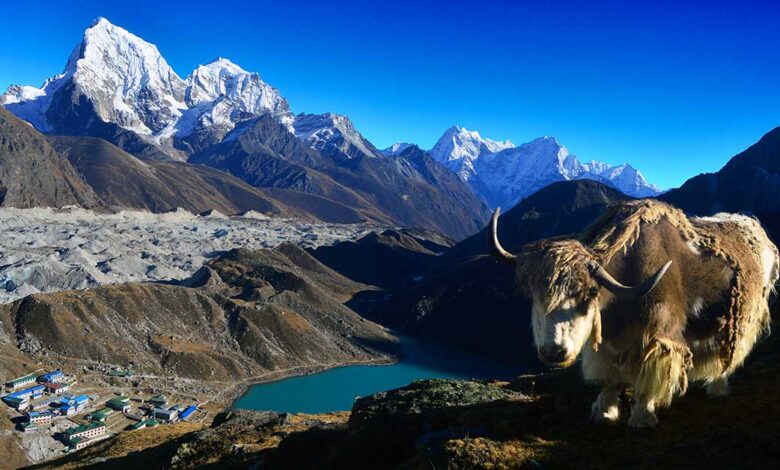Behind the Scenes of a Gokyo and Everest Base Camp Trek Sherpa Stories from the Himalayas

A world of hidden stories, challenges, and experiences that extend beyond the average trekking path. Sherpas, who are the unsung heroes of these expeditions, are also the key source of success during the journey. Their stories are interwoven with decades — sometimes centuries — of experience traversing the rugged landscape, braving extreme weather, and providing physical and emotional support to trekkers. These amazing people in many cases work behind the scenes making every trek happen, guiding their guests safely to some of the highest points on Earth.
Everest Trek Sherpas have a close link to the Himalayas, learned by heart over generations. For them, the mountains are more than a challenge — they are home. Their forefathers, who were also adept mountaineers, were among the earliest guides to lead expeditions up Everest, and this tradition persists today. It is this deep connection to the region and its spiritual significance that shapes their guiding philosophy. Sherpas often tell stories of their childhood in the Khumbu Valley how they learned to scale mountains from an early age, and how their relationship with the mountains applies to their everyday lives. Many of these guides describe the sacredness of the peaks with their work as more than just a job; it is their calling.
The Sherpa behind every successful trek is dedicated from the start when they accompany their group members (12-15 trekkers) during the initial stretch of the trek catering to their safety, comfort, and success. They are charged with logistical planning, managing acclimatization schedules, and troubleshooting problems on the fly, whether it is a sudden change in the weather or health complications. But they are more than logistics coordinators. They are present when fatigue and self-doubt creep in, brimming with supportive words, personal experiences of overcoming adversity, and a keen knowledge of the local area and its customs. They form a powerful bond, hazing older and younger generations into the majesty of mountain traveling, and the hard lessons learned in the high country. The people who walk the paths of survival, like the Sherpas who help you to the peak, bring their stories that connect the lanes to the footsteps of the heart of the Himalayas.
The Gokyo and Everest Base Camp Trek – an introduction
One of the most popular trekking paths in Nepal is the Gokyo and Everest Base Camp Trek, which is visited by trekkers around the world. The trek is a combination of two of the most famous trekking routes in the Khumbu region, allowing trekkers to witness the majesty of Mt Everest as well as the magnificence of Gokyo Lakes.
The Everest Base Camp trek is one of the most popular trekking routes that leads trekkers to the base of Mount Everest and provides some breathtaking views of this mighty giant along with other surrounding peaks including Lhotse and Nuptse. Trekkers pass through typical Sherpa villages like Namche Bazaar, Tengboche, and Dingboche along this route, both experiencing local culture and traditions. The Gokyo Lakes trek, however, takes trekkers to a chain of pristine, high-altitude lakes surrounded by snow-covered peaks, finishing with a hike up Gokyo Ri with sweeping views of the Everest massif and other Himalayan heights.
For travelers wanting a complete adventure, bringing both treks together is a lifetime opportunity. This trek is not just a test of physical endurance, but it also provides an opportunity to experience the rich heritage of the Sherpa people as trekkers move through the varied and rugged terrain of the Himalayas. This trek provides an unforgettable experience, both in terms of nature as well as culture.
Sherpas on Himalayan Expeditions
For decades, Sherpas have been the key to success in defeating the highest peaks of the world — guiding trekkers and climbers over some of the hardest ground in the world. Sherpas are an ethnic group indigenous to the high-altitude Himalayan regions of Nepal.
Traditionally, Sherpas have been used as expert guides and porters, having extensive local knowledge of the mountain paths, weather patterns, and geographical features. They’re trained in mountaineering skills, first aid, and survival techniques, so trekkers are safe while crossing the rugged, high-altitude terrain. Sherpas are vital members, not just in guiding but also in carrying heavy loads, establishing camps, and coordinating logistics on expeditions.
Besides their practical mastery, Sherpas come with strong social knowledge of the locality. Trekkers benefit from their knowledge of local customs, traditions, and spiritual practices, which enhances the cultural experience within the Everest region. The Sherpa guides are an essential part of a Himalayan expedition, many climbers and trekkers will consider their Sherpa guides to be an integral part of the journey, their loyalty and dedication to the job is unparalleled.
Behind the Scenes: Preparing for the Trek
Trekking to Everest Base Camp and Gokyo Lakes takes much more preparation than packing a backpack and hitting the trail. It was the preparation that went on behind the curtain of the high-altitude trek, which meant trekkers were well-geared, mentally prepared, and physically conditioned for the high-altitude trekking woes.
Physical fitness is one of the integral parts of being prepared. Trekkers must build their strength, endurance, and stamina through consistent training (hiking with a loaded backpack, walking on uneven ground, cardio, etc.). Acclimatization is also important, helping to avoid altitude sickness. Most trekkers spend a few days acclimatizing in Namche Bazaar or Dingboche, so their bodies can adjust to the very high-altitude conditions before continuing on to Everest Base Camp or Gokyo Lakes.
Everest Base Camp with Gokyo Lake Trek guide This means you need to be well equipped, from clothing suitable for long trekking in the cold to solid footwear, trekking poles, and decent sleeping bags for cold weather. Explaining the daily patterns of the trek, route conditions, and potential challenges helps set expectations and mentally prepares trekkers for the long days ahead.
It also involves securing permits and potentially hiring sherpas/guides as provided by сезенs for regulations. Guides explain the route and the local culture and make sure that trekkers are safe. Physical and logistical preparation increases the chances for a successful and enjoyable trek.
For Sherpas, Once Familiar Terrain Becomes the Trail of the Damned
A Sherpa is an ethnic group indigenous to the Himalayan region of Nepal and the average daily life of a Sherpa is quite different. Sherpas have a significant role in making a trekking journey smooth; guides, porters, caretakers, and doing pretty much every job at once.
Each morning starts early — typically before the sun comes up — with Sherpas orienting themselves in preparation for hitting the trail. They assist with packing, check that gear is prepared, and help coordinate that day’s logistics. Sherpas are frequently ahead on the trail en route to scout out the way, set up a tent, or even pilgrimage meals at the next lodge. They are experts in finding their way through tricky paths, crossing suspension bridges, and advising trekkers on the best routes to avoid danger due to their knowledge of local terrain.
In addition to leading, Sherpas carry heavy loads, often well over their own body weight, to ensure that the trekkers’ gear moves from point to point each day. Trekking is a very tiring and exhausting experience and Sherpa are the unsung heroes behind trekkers success. Trekkers stop, they tend to relax and enjoy nature, but Sherpas continue working hard for everything to be perfect and ensure that their guests have the most successful and unforgettable trekking experience.
After a long day’s trek, at day’s end, the Sherpas often find themselves clustered in the same tea houses as the trekkers, but their work doesn’t stop there. They ensure that the group is settling in and ready for the next day. Their day-to-day is physically demanding, but their mountain knowledge, dedication, and work ethic make them irreplaceable trail companions.
Sherpa Tales: Narratives from the Himalayas
Everest Base Camp with Gokyo Lake Trek difficulty Sherpas are the indispensable backbone of Himalayan expeditions, and their own stories are just as compelling as the mountains they navigate for trekkers. Most of the Sherpas have been trekking and guiding for years, and their experiences are often informed by the people, culture, spirituality, and resilience that define the Everest ecosystem.
One of those stories is a Sherp who remembers guiding climbers on a very bad snowstorm. Though many of the trekkers could not proceed, the Sherpa, with his knowledge of the mountain, led them through safer paths to help keep the group safe and continuing toward the destination. Other Sherpas also recount their upbringing in reticent, alpine villages, where they fleeced the craggy topography from a young age. Such stories showcase the closeness the Sherpas have to the land and the generations of knowledge that they bring with them.
Sherpas also offer unique insights about the culture and spiritual aspects of the Himalayas. Many have recounted visiting sacred monasteries, meeting spiritual leaders, and taking part in rituals that are meant to pay homage to the mountains. These personal journeys infuse their role as guides with emotional texture, allowing trekkers deeper access to the mountains, if not physically, then spiritually (and culturally).
The Difficulties of Trekking at High Altitude
Trekking at high altitudes, particularly in destinations such as Everest Base Camp and Gokyo Lakes, presents unique difficulties that demand specific preparation and awareness. Altitude sickness is one of the more pressing challenges. As hikers progress above 2,500 meters (8,200 feet), levels of oxygen in the surrounding airdrop, make it more challenging to get a breath. Symptoms of a lack of oxygen can include headaches, dizziness, nausea, and shortness of breath. Acclimatization is critical to minimizing these effects, so trekkers must take rest days and ascend slowly so that they can adapt.
The weather in the Himalayas can be unpredictable and extreme as well. Temperatures can plunge, particularly at night, and snowstorms or rain can render trails treacherous. Trekkers need to come prepared with the appropriate gear, from layers for warmth to outfits that provide waterproof protection and sturdy shoes to navigate slippery, rocky paths.
Additionally, the Everest area is a rough, uneven land that makes traversing difficult. Climbing steep hills, stepping over rocks, and crossing suspension bridges over deep valleys need attention and strength. High-altitude trekking involves long days of walking with few of the comforts of the modern world, so it takes a lot of mental and physical endurance. However, if you want to experience the world’s most majestic views and an experience at the base of Mount Everest, then high-altitude trekking is a once-in-a-lifetime adventure.
Establishing Trust Between Trekkers and Sherpas
Everest Base Camp with Gokyo Lake Trek duration Establishing trust is an integral part of a successful trek in the Himalayas and between trekkers and Sherpas. Due to the numerous obstacles in the form of challenging terrain, unpredictable weather, and the rigors of high-altitude trekking, it becomes essential for trekkers to entrust their faith in experienced Sherpa guides. This relationship is built on mutual respect, open communication, and shared goals. Sherpas are knowledgeable about the routes, and they hold the responsibility of making sure trekkers are safe and healthy, while the trekkers depend on Sherpas for guidance, support, and local knowledge.
This reliance is based on the Sherpas’ rigorous preparation, their familiarity with the land, and their strong bond with the mountains. For trekkers, the safety and comfort that come from trusting their guides allows them to enjoy the stunning beauty of the region without being preoccupied with risk. Sherpas will make a point of learning the requirements and proficiencies of each trekker, modifying the speed, and providing pep talks when needed.
As their journey progresses, trekkers start to recognize the Sherpas not only as guides but as friends, frequently sharing meals, tales, and adventures. This sense of fellowship deepens the bond, transforming the climb into a collective pilgrimage. Trekkers often forge strong bonds with their Sherpa guides, which helps them conquer their physical challenges on the trail but also develop a deep respect for the cultural and spiritual significance of the mountains, enriching their adventures on many levels.
Sherpa Culture and Traditions
The culture and traditions of the Sherpas are intertwined with the stunning landscapes of the Everest and Gokyo regions, and trekkers can immerse themselves in the rich heritage of the Khumbu Valley. The Sherpas are an ethnic group of Tibetan origin who have settled in the high-altitude areas of Nepal for centuries, their culture adapted to the environment they live in. Buddhist faith touches many aspects of everyday life: Chortens and prayer flags embellish the hills, and temples are frequent sights.
These Sherpas are known for their strong community and sense of family. In the close villages, no one is a stranger, and living together in the neighborhood is governed by shared values of hospitality, respect, and cooperation. These values are handed down from generation to generation, and the younger Sherpas learn the wisdom of the mountains, both for physical survival and as carried in the culture.
Everest Base Camp via Gokyo Lakes For trekkers, this is one of the richest rewards of their sojourn. But there is a myriad of ways to see the Sherpas, and whether they be preparing a meal with a local family, joining a festival, or learning about Buddhist traditions, the Sherpas provide reflections of a lifestyle that has not changed much in centuries. With their warm hospitality and desire to share their culture, the trekking experience becomes more than just a physical challenge; it’s a chance to connect with people whose roots run deep in the heart of the Himalayas.
A Sherpa’s Perspective on Navigating the Terrain
Given its feature of extreme altitude and rough terrains, navigating the routes of the Everest Base Camp and Gokyo Lakes treks is no easy task and is one that is only possible if you have done observations at the Gokyo Lakes. To a Sherpa, though, this terrain is second nature. Sherpas have traversed these treacherous roads for generations, honing a natural sense of direction and a preternatural ability to read the restless state of the mountains. Their knowledge of the terrain is so intimate that they can lead trekkers through narrow mountain passes, across precarious suspension bridges, and through villages clinging to steep hillsides.
The terrain offers its own peculiar hurdles. In high-altitude passes like the Cho La Pass or the rough rugged trails to Gokyo Lakes, it is important to plan well, take it slow, and most importantly seek local expertise. Sherpas are in sync with the subtleties of weather, the rhythms of the land, and the dangers that may not be obvious to an outsider. They know when to accelerate or decelerate when to rest, and when to press on.
For trekkers, having a Sherpa navigate the terrain means not facing the potential dangers of unfamiliar geography. This takes us to the season of summer trekking across the Himalayas, where Sherpas are experienced enough to navigate effortlessly and professionally without putting anybody at risk, even in the harshest of conditions. They draw on their experience to react quickly to changing conditions, be it a sudden snowstorm, a wind shift, or an unexpected illness. It is a Sherpa’s intimate knowledge of the terrain that often tips the scales between a successful trek or descending into a dangerous situation.
Upon arriving in Kathmandu, a trekker faces the additional decision of hiring a sherpa.
Sherpas are an essential part of a safe and successful trip to Everest Base Camp or Gokyo Lakes. Being mountaineers and guides themselves, they know the terrain and unpredictable weather, as well as the physical toll that high-altitude trekking takes on a body. That role is far more than pioneering the route — he is critical in aiding the management of the risks that come from navigating one of the world’s most remote and unforgiving regions.
EBC with Gokyo Lake and Cho La Pass Trek First of all, Sherpas help trekkers adjust to the high altitudes. Their understanding of altitude sickness and its initial signs is vital to maintaining keeping trekkers healthy. They lower the risk of serious altitude sickness or other health risks associated with altitude significantly, by recommending adequate rest days, adjusting the pace, and making sure trekkers are rested and adequately hydrated and nourished.
Sherpas also receive training in high-altitude first-aid skills and are usually the first on the scene in an emergency. Their knowledge of medical procedures, along with their quick thinking, can mean the difference between a small setback and a deadly situation. Their knowledge of the region enables them to rapidly determine if they should continue, descend, or seek medical assistance.
The other main contribution that Sherpas provides qualifications for is route planning and logistics during the summit. They know the best trekking trails; they avoid dangerous areas, and they change the itinerary if the weather shifts. The people with the pots and pans — known these days as the crew — allow trekkers to concentrate on the physical and emotional elements of the trek while the logistics and safety are taken care of.
Emotional and Physical Cost of the Journey
The trek to Everest Base Camp and Gokyo Lakes is physically and emotionally draining. The high-altitude landscape, variable weather, and long days of trekking can wear down even the most experienced hikers. The trek in comparable terms is also severe, taking trekkers to routinely walk for long hours in a single day, sometimes on steep or rocky paths or uneven valued ground. The thin air and lack of oxygen at high altitudes complicate breathing, and altitude sickness produces such symptoms as headaches, dizziness, nausea, and fatigue, which can impede progress.
On top of the physical challenges, there is the emotional toll. The isolation, the wide reaches of the landscape, relentless pace of the trek can combine to induce fatigue and homesickness. Many trekkers are overcome with self-doubt, wondering whether they can go on. These are precisely the moments of struggle in which a Sherpa is worth their weight in gold.
The Sherpas also provide essential mental motivation, as their role goes well beyond physically assisting climbers. Calm, positive, and understanding of the challenges faced by trekkers, they gently offer words of encouragement at times of need. The Sherpas themselves are familiar with the emotional and physical strain of the trek and have their own experience to guide trekkers through these moments. The trek can be challenging, yet having a Sherpa to lean on as a guide, provides trekkers to muster up the strength to carry on to the end.
Final Thoughts: Unsung Heroes of the Himalayas
Ruling over the snow-clad realm of the Himalayas are the Sherpas of the high-altitude region of Nepal who play the role of invisible angels behind your Everest Base Camp or Gokyo Lakes trek. And while trekkers may be focused only on reaching where they’re going, it is the Sherpas who ensure the trip is safe, enriching, and fulfilling. Sherpas, with their unrivaled experience of the region, culture, and height, lead, assist, and guard every step of the way.
EBC Cho La Pass trek I think it is safe to say that they contribute much more than just muscle: They become cultural ambassadors, educators, and emotional supports along the trail. So not only do Sherpas guide the trekkers up to Everest base camp but they also share stories, their wisdom, and their connection to the mountains, helping trekkers gain a fuller understanding of the journey. The bonds formed based on trust, camaraderie, and respect become life-long as trekkers and sherpas build lasting relationships that transcend their climb — it becomes not only a physical challenge but an experience like no other that changes lives.
We wouldn’t describe the Everest Base Camp and Gokyo Lakes trek as the most amazing adventure without Sherpas. It is their hard work, commitment, and knowledge that enables these adventures to happen and their work as guides, guardians, and friends is immeasurable. In many ways, Sherpas are the heart, and soul, of Himalayan trekking, and their contribution to these adventures is what makes them truly unforgettable.





